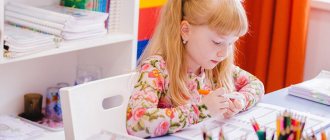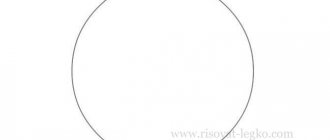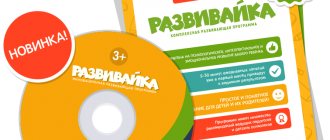Project “Logic for children 4-5 years old”
Explanatory note
The need for the purposeful formation of logical methods of thinking in the process of teaching and upbringing is already recognized by psychologists and teachers. Famous child psychologist L.S. Vygotsky was one of the first to formulate the idea that a child’s intellectual development lies not so much in the quantitative stock of knowledge, but in the level of intellectual processes, i.e., in the qualitative features of children’s thinking. He argued: “Scientific concepts are not absorbed and memorized by a child, they are not taken into memory, but arise and are formed with the help of the tension of the entire activity of his own thought.” But why should a preschooler develop thinking? The fact is that at each age stage, a certain “floor” is created, on which mental functions that are important for the transition to the next stage are formed. Thus, the skills and abilities acquired in the preschool period will serve as the foundation for acquiring knowledge and developing abilities at an older age. And the most important among these skills is the skill of logical thinking, the ability to “act in the mind.” Having mastered logical operations, the child will become more attentive, learn to think clearly and clearly, be able to concentrate on the essence of the problem at the right moment, and convince others that he is right. It will become easier to study, which means both the learning process and school life itself will bring joy and satisfaction. Knowledge of logic will contribute to the cultural and intellectual development of the individual.
A child who has not mastered the techniques of logical thinking will find it more difficult to study: solving problems and doing exercises will require a lot of time and effort. As a result, the child’s health may suffer and interest in learning may weaken or even disappear completely.
Modern pedagogical and methodological literature offers teachers a variety of techniques that stimulate the intellectual development of preschoolers. However, in the literature it is difficult to find a comprehensive set of tools, techniques and methods, the totality of which makes it possible to ensure the manufacturability of this process. The practice of working with children of senior preschool age has revealed that children often cannot identify signs of generalization by naming the generalizing concept itself; cognitive activity is often reduced, and this inhibits the development of a creative personality. In my opinion, the most constructive solution to the problem is the idea that the systematic development of forms and operations of logical thinking on material accessible to children in a playful form contributes to the development of children’s cognitive activity, creative and logical thinking, independence and systematic thinking.
Target:
development of logical thinking of a preschooler through play activities: teach by playing.
Tasks:
- Develop visual perception, attention, memory, logical thinking of children.
- Develop visual-figurative thinking.
- Develop the skill of reasoning, drawing conclusions, contrasting, comparing, analyzing, and establishing simple patterns.
- To develop the ability to find and complete missing fragments of images, to identify an object by individual parts.
- Foster independence, initiative, and perseverance in achieving goals.
The project was developed for children of middle preschool age (4-5 years old).
Project implementation period
- one year.
Expected Result
:
- The ability to independently and persistently achieve goals has been developed.
- Children show curiosity and interest in research activities.
- Children have developed attention, perception, and logical thinking.
- Children successfully solve logic problems.
- Preschoolers show a steady interest in educational games.
- Developed ability to analyze, reason, compare, and draw conclusions.
Plan of joint activities with children of the middle group to develop mental abilities through didactic games and exercises
| month | tasks | activity logic | ||
| October lesson 1 | 1. Strengthen the ability to quickly find a geometric figure. 2.Develop the ability to find the missing figure. 3. Exercise children to lay out cars according to a pattern. | 1.I/u “Find and name.” 2.I/u “Complete the figure.” 3. Designing machines from geometric shapes | ||
| lesson 2 | 1. Practice finding geometric shapes. 2.Develop voluntary attention. 3. Exercise children to lay out the fish according to the pattern. | 1.I/u “Find and name.” 2.I/u “Find the missing figure” (complete the figure). 3.Laying out the fish according to the pattern. | ||
| lesson 3 | 1. Exercise children in drawing up geometric figures on a table from a count. sticks and threads 2. Exercise children to lay out a pattern using sticks. | 1.I/u “Make a figure: a square and a triangle; small and large square; from threads circle, oval, triangle, square. 2. Laying out the pattern according to the sample. | ||
| lesson 4 | 1.Practice in composing geometric shapes. 2.Develop the ability to compose figures according to a model. 3.Develop logical thinking and attention. | 1.Make: 2 equal triangles from 5 sticks; Of 10 sticks, 3 are equal squares; Of 7 sticks, 2 are equal squares. I/u “What’s missing.” Name the missing figure | ||
| november lesson 1 | 1.Consolidate knowledge about geometric shapes. 2.Develop the ability to arrange figures according to instructions. 3.Train children to find objects, develop attention and observation. | 1.Color the shapes that have 3 corners and the extra shape. 2. Arrange the figures: red circle, to the left of it is a yellow triangle, to the right of the circle is a green triangle; 3. Cards (noisy) - finding objects. | ||
| lesson 2 | 1.Develop logical thinking. 2.Develop voluntary attention. | 1.I/u “What’s outside, what’s inside” 2.I/u “Make it according to the model.” 3.I/u “Sequence” Arrange the cards according to the pattern. | ||
| lesson 3 | 1. Exercise the ability to compose new geometric shapes 2. Develop attention and observation. | 1.Introduction to the tangram game. 2.I/u “Which figure is extra.” | ||
| lesson 4 | 1.Develop logical thinking. 2.Develop voluntary attention | 1.I/u “Outlining” 2.I/u “Make it according to the model.” 3. I/u “Find the differences” | ||
| December lesson 1 | 1.Use buttons to develop verbal and logical thinking. 2.Develop logical thinking, voluntary attention 3.Train children to find an extra object | I/u “Find the extra button” a) extra in color b) extra in size c) extra in the number of holes d) extra in shape D/i “Paired rugs” D/i "The Fourth Wheel" | ||
| lesson 2 | 1.Develop voluntary attention. 2.Develop attention and observation skills 3.Train children to find objects, develop attention and observation. | I/u "Contours" D/i "Rezinochki" Cards (noisy) - finding objects | ||
| lesson 3 | 1. Practice composing geometric shapes 2. Develop voluntary attention | I/u “Make a square” I/u "Outlining" | ||
| January lesson 1 | 1.Practise drawing up the geometric shape of a square 2.Use buttons to develop verbal and logical thinking 3.Develop logical thinking. | I/u “Make a square” I/u “Continue the row of buttons” a) red and blue buttons alternate b) 2 red and 2 blue buttons alternate c) blue, red, orange buttons alternate d) buttons with different numbers of holes alternate D/i “What’s wrong” | ||
| lesson 2 | 1.Use buttons to develop verbal and logical thinking 2.Develop voluntary attention 3.Train children to find an extra object | I/U “Find a button according to the description”" a) Find a small red button b) Find a large black button with 4 holes c) Find a small white button with 4 holes d) Find a large blue button with 2 holes I/U “Find an extra object » 3 D/i “The Fourth Wheel” | ||
| February lesson 1 | 1.Use buttons to develop verbal and logical thinking 2.Develop attention and observation skills 3.Develop voluntary attention | I/U “Add buttons to the rows” What buttons are missing in each row? Make sure there are equal numbers of buttons in all rows. I/u “Find the missing figure” (complete the figure) I/u “Make it according to the model.” | ||
| lesson 2 | 1.Develop attention and observation skills 2Train children to find an extra object 3.Develop attention and observation skills | D/i "Find the differences" D/i "The Fourth Wheel" D/i “Rubber bands (2nd option) | ||
| lesson 3 | 1.Practise making geometric shapes from sticks according to the pattern 2.Use buttons to develop verbal and logical thinking 3.Develop attention and observation skills | I/u “Make it according to the model.” I/u “Logical operation" a) arrange the buttons: red ones in one circle, small ones in another; b) arrange the buttons: with 4 holes in one circle, small ones in the other. D/I “What did the artist mix up” | ||
| March lesson 1 | 1.Use buttons to develop verbal and logical thinking 2.Develop voluntary attention 3.Develop logical thinking. | I/u “Put the buttons into bags” a) arrange the buttons by color b) arrange the buttons by size c) arrange the buttons according to the number of holes I/u "Labyrinths" D/i “What’s wrong | ||
| lesson 2 | 1Train children to find objects, develop attention and observation. 2.Develop logical thinking. 3.Develop voluntary attention | Cards (noisy) - finding objects D/i "Sequence" I/u “Make it according to the model.” | ||
| lesson 3 | 1.Develop the ability to arrange figures according to instructions. 2.Develop voluntary attention 3.Train children to find an extra object | I/u “Make it according to the model.” I/u "Find the differences" D/i "The Fourth Wheel" | ||
| lesson 4 | 1.Practise drawing up the geometric shape of a square 2.Develop logical thinking and attention 3.Develop voluntary attention | I/u “Make a square” (Option 2) I/u “What’s missing.” Name the missing figure I/u “Make it like this” | ||
| April lesson 1 | 1.Practise the ability to compose figures according to a model 2.Develop logical thinking and attention 3Exercise children in making figures on the table from counting. sticks according to the pattern | D/i "Tangram" I/u “What’s missing.” Name the missing figure I/u “Make a figure | ||
| lesson 2 | 1.Develop voluntary attention 2.Develop attention and observation skills 3.Develop attention and observation skills | I/u "Labyrinths" D/I “What did the artist mix up” I/u “Find the missing figure” (complete the figure) | ||
| lesson 3 | 1.Develop attention and observation skills 2.Develop voluntary attention 3Train children to find an extra object | I/u “Find an item that doesn’t fit with the others” D/i "Silhouettes" D/i "The Fourth Wheel" | ||
| lesson 4 | 1Develop the ability to coordinate a pronoun with a noun. 2Develop attention and observation skills 3Practise the ability to compose figures according to a model | Speech game “Settled in houses” D/i “What is what” D/i "Tangram" | ||
Final event:
game – quiz “Smart guys and smart girls”
Bibliography:
BEHIND. Mikhailov "Game entertaining tasks for preschoolers", Moscow "Enlightenment" 2009. V.P. Novikova “Mathematics in kindergarten”, Moscow Mosaic-Synthesis 2009. “500 tasks and tasks for children”, Creative Center Sphere 2009. E.N. Petlyakov “Developing memory and attention”, Phoenix Rostov-on-Don 2012.
https://psi-school.ru/logicheskie-igry-s-pugovicami/
https://www.babyblog.ru/community/post/parentalschool/3169149
https://mirdetstva5.ru/obschii-zanyatiya-s-rebyonkom/razvivayuschaya-igra-chto-pereputal-khudozhnik#
https://ot2do6.ru/77-volshebnaya-obvodilka.html
https://www.liveinternet.ru/users/svetlana-sima/post213452433/
https://mirdetstva5.ru/obschii-zanyatiya-s-rebyonkom/razvivayuschaya-igra-chego-ne-khvataet
https://prodetstvo.ru/games/log/log4/
https://vk.com/smart_children
Logical thinking in early preschool age
Junior preschool age covers the period from 2 to 4 years. At this time, the child learns to compare objects and classify them according to such elementary characteristics as color, shape, size.
Developmental activities at this age are best carried out using bright toys or flashcards. It is desirable that the images are as simple as possible and contain a minimum of distracting details.
Activities with your child teach him to think logically.
Logical tasks for younger preschoolers are varied. Typical exercises to develop logic at this age could be:
"Place it in order"
The game helps the child understand cause and effect relationships, and also improves his perception of time.
For this activity you will need cards with pictures of animals and their babies. Children can be asked to match each card with a pair, having first laid out adult animals in front of him and given him the babies. After all the cards have taken their places, you can explain to the child that a tiny chicken eventually grows into a chicken or a rooster, a puppy grows into a dog, etc. Over time, this task can be complicated by offering the child pictures depicting scenes from his favorite fairy tales. And offer to put them in order, restoring the plot.
Matching game
"Finish the chain"
The child is offered logical chains of objects or pictures belonging to a certain class: these can be flowers, trees, animals or birds. And next to it is a group of different pictures, among which there should be one that belongs to the items in the chain. The child’s task is to complete the chain with a suitable element.
This task, despite its simplicity, well develops the ability to generalize and analyze, compare and classify.
“Whose subject?”
In this task for preschoolers, you can ask the child to name:
- items used by representatives of various professions;
- parts of certain machines or devices;
- parts of the human body, animals, birds;
- elements of houses.
Online game Find exactly the same cat - the child can play on the Internet
"Remove the unnecessary"
A group of pictures depicting various objects or toys is laid out in front of the child, among which there should be one extra one that does not fall under the general category. The child’s task is to find and remove this object using logical thinking. It is very desirable that the child can also explain his choice, telling why this or that item turned out to be superfluous.
Game Choose the smallest object
Over time, the task can be somewhat complicated by adding specific objects with natural phenomena, colors, etc. The logical connections between them are somewhat more complicated and in order to cope with this task the child will need to try very hard.
General rules for the development of logic in a child
The main activity in preschool age for a child is play. However, despite this, logic plays an important role for preschoolers. Imagination during this period is not yet well developed and in order for learning to be easier and more effective, during classes it is necessary to use a maximum of visual material: toys, pictures, puzzles, counting sticks, etc. Bright didactic material will turn any activity into an exciting game in which the child will be happy to take part.
Geometric shapes - developing logic in a playful way
As the child grows up, he will need demonstration material less and less. And the solution of more and more problems will take place in the mind, using verbal and logical thinking.
Classes to develop logic in older preschool age
The senior preschool period is marked by the intensive development of many mental processes. In particular, by the age of four, children begin to develop verbal and logical thinking, which allows them not only to solve certain tasks, but also to clearly argue their position.
Joint games develop logic in older preschoolers
The child no longer needs clarity due to a fairly well-developed imagination and an increase in memory capacity. And although it is still advisable to use all kinds of didactic material in classes, already at 4 years old you can ask your child to solve some problems in his head.
Here are just some logic tasks for older preschoolers.
"Ranging"
The development of preschoolers’ thinking processes is greatly facilitated by ranking (for example, by size, color, and later by the degree of expression of a particular feature). It is imperative to clarify to the child what exactly serves as the basis for ranking.
The Find the Difference game is a type of ranking game.
"General and Particular"
By older preschool age, the child’s conceptual apparatus has already fully formed ideas about the general and the particular. Therefore, he can already be asked to complete tasks on this topic.
Logic maze is a favorite pastime of preschoolers
Games to form ideas about the general and the particular are quite simple. It is enough just to lay out objects or cards with objects of the same type in front of the child and invite the child to determine the logical connections between them, calling them in one word. Just like in previous games, here you need to move from simple to complex, first using the simplest categories, where the common feature will lie on the surface. And over time, complicate the task by expanding the number of groups used.
If preschoolers encounter any difficulties while completing tasks, you should definitely talk to them about it. And solve the problems that arise together.
The thinking processes, in particular, logic, of preschoolers develop at a fairly intensive pace and by the time they enter school they are already at a good level, which allows them to assimilate the school curriculum as efficiently as possible.
leave a comment






